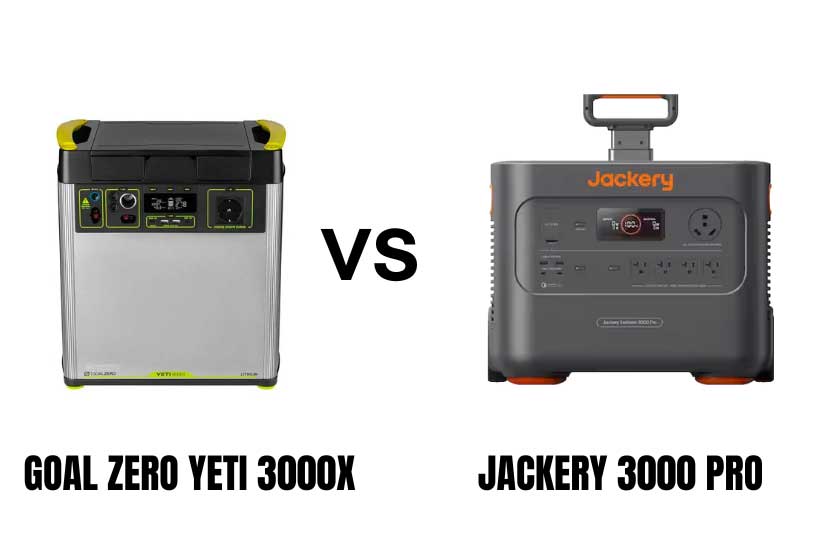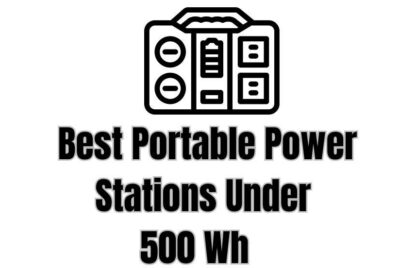Goal Zero Yeti 3000x Comparison With Jackery Explorer 3000 Pro
I may earn a commission for purchases made through my links. It helps me run this site. Check out my disclosure for more details.
Now that portable power stations are firmly on the menu for anyone who wants backup power and power for when they go off-grid (camping, hiking, work sites, RV tours), it’s important to compare the features and options of the leading brands to see what is the best fit for your needs. In this comparison, we will take a closer look at the Goal Zero Yeti 3000X Portable Power Station and the Jackery 3000 Pro Portable Power Station. These sit in the higher echelons of the watt-hours alternative power market. They are both extremely well equipped for running small to large household appliances and, naturally, for covering low-power-consuming devices and keeping them running for days or weeks.
First, let’s start with the similarities between the two models. Both the Goal Zero Yeti 3000X and the Jackery 3000 Pro (reviewed here) have a capacity of approximately 3000 watt-hours, making them powerful options for extended off-grid use or emergency backup power. They also both have multiple charging options, including AC outlets, USB ports, and DC outlets, allowing you to charge a variety of devices.
Jackery 3000 Pro Has Faster Recharge Times
However, when it comes to differences, there are several worth noting. The Goal Zero Yeti 3000X has a 2000W continuous output and a 3000W surge capability, while the Jackery 3000 Pro has a higher 3000W pure sine wave inverter with a 6000W surge capability. This makes the Jackery 3000 Pro a better option for powering high-wattage devices like power tools or larger appliances.
Another difference is in the charging time. The Goal Zero Yeti 3000X can be charged in about 6 hours using the upgraded 600W wall charger or between 18-36 hours using a single 200W Boulder Briefcase solar panel. The Jackery 3000 Pro, on the other hand, can be charged in about 2.4 hours using the included wall charger or in about 19 hours using one of Jackery’s 200-watt SolarSaga panels. So if you’re looking for a faster charging time, the Jackery 3000 Pro is the better option.
Charging times drop to 2.8 hours if you use six of Jackery’s 200W solar panels. Here are the recharge times for the 3000 Pro with panels:

Transportation
In terms of portability, the Jackery 3000 Pro is slightly lighter at 63 pounds compared to the Goal Zero Yeti 3000X’s weight of 69.78 pounds, but that’s nothing to write home about. However, the Goal Zero Yeti 3000X comes with a roll cart for easier transport, while the Jackery 3000 Pro has an extendable handle and double wheels, so both get a point for easy moving.
Finally, when it comes to price, both of these power stations without any solar panels are roughly the same price, just under $3k on their own websites at the time of writing.
| Feature | Goal Zero Yeti 3000X | Jackery 3000 Pro |
|---|---|---|
| Capacity | 3032 watt-hours | 3024 watt-hours |
| Inverter | 2000W continuous output, 3500W surge capability | 2000W pure sine wave inverter, 6000W surge capability |
| Battery Life | 500 cycles to 80+% | 2500 cycles to 70+% |
| Dimensions | 15.25 x 10.23 x 13.6 in | 18.6 x 14.7 x 14.1 inches |
| Charging time | 14 hours with 230W wall charger, 6 Hours with optional 600W wall charger, 18-36 hours with 1 x 200w Boulder Briefcase solar panel | 2.4 hours with AC Power, 19 hours with 1 x 200w solar panel |
| Weight | 69.78 pounds | 63.93 pounds |
| Portability | Comes with roll cart for easier transport | Has Wheels and retractable aluminum alloy pull rod handle |
| AC output | 120V, 60Hz, pure sine wave | 120V, 60Hz, pure sine wave |
| DC output | 12V, 10A carport, 12V, 30A Anderson Power Pole | 12V, 10A carport, 12V, 30A Anderson Power Pole |
| USB output | 4 USB ports, 5V, up to 2.4A per port, USB-C PD 20V, up to 3.0A | 2 USB-A ports, 5V, up to 2.4A per port; 1 USB-C port, 5V-20V, up to 3A |
| Output connections | 2 AC outlets, 2 USB-C ports, 4 USB-A ports, 1 12V carport, 1 12V Anderson Power Pole | 3 AC outlets, 2 USB-C port, 2 USB-A ports, 1 12V carport, 1 12V Anderson Power Pole |
| Warranty | 2 Years as standard, optional 3 year extended warranty | 3 Year warranty optional extended 2 year warranty |
Overall, both the Goal Zero Yeti 3000X and the Jackery 3000 Pro are powerful and versatile portable power stations with similar capacities and charging options. However, the differences in inverter power, charging time, portability, and price may make one model a better fit for your specific needs.
If you need a more powerful inverter for high-wattage devices, the Jackery 3000 Pro is the better choice. If you prioritize faster charging times, the Jackery 3000 Pro also has a slight advantage. The game-changer for me though, is that the battery life is five times longer with the Jackery 3000 PRO. A 500 battery lifecycle, which the Yeti 3000X has, is going to start to fade after 12–24 months, depending on how much you use it. For a power station costing close to $3k, that is a bit weak.
Jackery also has an extra year’s warranty as standard, although whichever model you choose, I would be extending the warranty to 5 years just for peace of mind. One thing that is certainly annoying about the Yeti is Goal Zero makes you pay a couple hundred bucks extra if you want the faster 600W power supply. This drops wall charging to 6 hours, the included 230W charger takes 14 hours to recharge. Which is certainly not something I’d want to be stuck with.
Goal Zero does have several expansion battery kits for this system that will provide an extra 1200-4800 watt-hours of battery power. You also need to buy an extension module for it to connect which costs $several hundred dollars. But if you want more power for backing up your home, this system is cost-effective compared to splashing out on the more expensive Yeti 6000X. So this is something to think about if you want the 3032Wh of power plus something a bit extra for home grid integration. You cannot expand the Jackery 3000 Pro at all, so Goal Zero certainly earns brownie points for their expansion ability. Jackery makes the 2000 PLUS, which can expand, but the power station itself has only 2042Wh of power (although it can expand to 12024 watt-hours!).
Ultimately, the decision between these two models comes down to your individual needs and preferences. No matter which model you choose, a portable power station is a great investment for off-grid adventures, emergency backup power, or simply as a reliable source of electricity on the go.
What Can A 3000w Solar Generator Power?
A 3000 watt solar generator is capable of powering a wide variety of devices and appliances, making it a great option for off-grid living, camping, or emergency backup power. With a capacity of 3000 watt-hours, a 3000 watt solar generator can power devices like a mini fridge, coffee machine, LED lights, laptops, heated blankets, TVs, and more. It’s important to note that the specific run times for each device will vary depending on factors like the device’s wattage, the generator’s battery capacity, and the amount of sunlight available for solar charging.
To give you an idea of what a 3000 watt solar generator can power, let’s take a look at some example run times for specific devices and appliances:
| Device/Appliance | Wattage | Run Time (Hours) |
|---|---|---|
| TV | 100W | 30 |
| Mini fridge | 80W | 37.5 |
| Coffee machine | 1000W | 3 |
| LED light | 10W | 300 |
| Laptop | 50W | 60 |
| Electric grill | 1500W | 2 |
| Microwave | 1000W | 3 |
These run times are just examples and will vary depending on the specific model of the device and the solar generator being used. It’s important to check the device’s wattage and the generator’s capacity to ensure that they are compatible and to get an accurate estimate of run time.
As well as providing a reliable source of power, a 3000 watt solar generator is also a more eco-friendly option compared to traditional gas generators. By harnessing the power of the sun, solar generators produce clean energy without the need for fossil fuels. They are also a lot safer to use and have built in protection systems to stop them from overheating or overcharging your devices and appliances. Plus, one large capacity solar generator can save you from carrying around loads of power bricks!
Overall, a 3000 watt solar generator is a so handy when you are working or entertaining in the great outdoors and want your own power source, naturally they excel in camping trips especially if you are exploring more exotic wild camps with no grid power source. If you have a large house with freezers, and medical devices, you need some sort of generator to keep you going. The good thing about solar battery generators compared to fuel generators is that you won’t need to worry about toxic fumes, and you can run a solar generator indoors. With the ability to connect to your home grid, especially when the power goes down, the future is certainly bright for portable power stations.
Jackery 3000 PRo vs Goal Zero Yeti 3000X – Who Wins?
One caveat, I really love the Yeti 3000X. I love its sleek metallic block-like design. I have no problems with the power output. The expansion options are also amazing. The Jackery, in my opinion, certainly edges it, as it has 2 more AC outlets. The recharge times are a lot faster, and the battery life is miles ahead of the Yeti. Goal Zero also makes you pay extra for faster AC charging. And that, to me, is the crux of it. Pound for pound, based on their individual merits, one of these units is better. It’s a win for Jackery.
Further Jackery Content
Check out how Jackery copes up against EcoFLow here
Full breakdown of these Jackery Models here:




